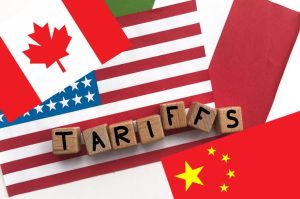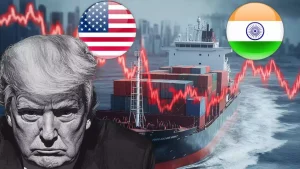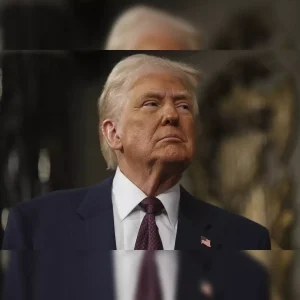Washington: In a bold and controversial move that sent tremors across global financial markets, U.S. President Donald Trump has reignited international trade tensions by announcing a fresh wave of reciprocal tariffs targeting several key trading allies, including India, China, and the European Union. Speaking at a high-profile press briefing in Washington, Trump defended the abrupt shift toward protectionism, stating confidently, “Oil prices are down, there is no inflation — we have room to act.”
This declaration comes amid a fragile phase for the global economy, still recovering from the aftershocks of the COVID-19 pandemic, supply chain disruptions, and ongoing geopolitical flashpoints such as the Russia-Ukraine war and tensions in the South China Sea. The announcement immediately sparked a cascade of concerns among economists, global policymakers, and investors, who worry that such measures could ignite a new era of trade wars, derail economic stability, and fracture multilateral cooperation just as the world economy shows tentative signs of revival.
Trump’s reassertion of “America First” trade policies has raised alarm bells about a potential return to the tariff battles that defined his first term — battles that had far-reaching consequences for both developed and emerging markets. The timing of this policy, when inflation in several parts of the world has only recently begun to cool and consumer demand remains uneven, has only intensified global unease.
Also Read: Singapore at a Strategic Crossroads Amid Rising U.S. Protectionism: PM Wong Reacts
A Return to Trade War Tactics
The recent tariff announcement marks a resurgence of Trump’s trademark trade war tactics, reminiscent of his 2017–2020 presidency, where he frequently invoked the mantra of “America First” to justify sweeping economic actions. Central to his approach was the goal of narrowing the U.S. trade deficit by targeting what he deemed “unfair” trade practices. The renewed proposal now seeks to implement high reciprocal tariffs on imports from countries that impose steeper tariffs on American goods — a strategy aimed at forcing trade partners to reduce their barriers or face stiff economic consequences.
What has alarmed many observers is the timing of this aggressive policy shift. The global trade ecosystem remains precariously balanced, still attempting to recover from the pandemic-era supply chain collapses, shipping delays, and inflation-driven demand shocks. Compounding these challenges are ongoing geopolitical tensions — including the Russia-Ukraine war, escalating hostilities in the Middle East, and the growing strategic contest between the U.S. and China in the Indo-Pacific region.
 Trump singled out nations such as India and China, claiming they have “taken advantage of the U.S. for too long” by maintaining trade imbalances and protecting domestic industries with high tariffs. His rhetoric emphasized a zero-tolerance policy toward asymmetrical trade deals, asserting that these measures were essential to restore fairness and competitiveness for American manufacturers, farmers, and workers.
Trump singled out nations such as India and China, claiming they have “taken advantage of the U.S. for too long” by maintaining trade imbalances and protecting domestic industries with high tariffs. His rhetoric emphasized a zero-tolerance policy toward asymmetrical trade deals, asserting that these measures were essential to restore fairness and competitiveness for American manufacturers, farmers, and workers.
While the move may resonate with certain domestic constituencies, critics argue that retaliatory tariffs risk triggering a tit-for-tat cycle, potentially destabilizing global commerce and undermining diplomatic relations just when unity is needed most.
The Economic Justification: Oil & Inflation
In a key part of his address, President Trump framed the new tariff strategy as both economically sound and politically timely, asserting that the current global financial conditions offer a rare window of opportunity. He pointed to the recent decline in global oil prices and the cooling of domestic inflation rates as factors that provide the U.S. with the fiscal and monetary leeway to take bold trade actions without significantly affecting American consumers.
“We have low energy prices. Inflation is not a concern anymore. We can use this moment to strengthen American manufacturing,” Trump declared, in a statement that drew both applause and apprehension.
Indeed, crude oil prices have retreated in recent weeks due to increased output by key producers like the U.S., Saudi Arabia, and Brazil, coupled with a relative stabilization in global supply chains. However, many economists warn that this is a temporary relief, and introducing broad-based tariffs could reverse the disinflationary trend.
Tariffs on essential imports — including electronics, automotive components, machinery, textiles, and consumer goods — may directly lead to higher production costs, which would ultimately be passed down to consumers. This, they argue, could erode purchasing power, tighten household budgets, and even compel the Federal Reserve to revisit interest rate policies if inflation reaccelerates.
Furthermore, critics note that the benefits to domestic manufacturing, while real in select sectors, often take time to materialize, whereas price hikes from import taxes tend to hit consumers and businesses almost immediately. In a globalized economy, where production networks are deeply interlinked, protectionism can introduce more volatility than stability.
Global Reaction: Alarm Bells Ring
Trump’s sweeping tariff announcement reverberated across continents, drawing swift condemnation and concern from major global powers and economic blocs. As the implications of a renewed trade war loomed large, the global diplomatic and financial community responded with alarm.
India’s Ministry of Commerce issued a strongly worded statement expressing “deep concern over the unilateral and unexpected announcement”, emphasizing that trade decisions with such significant consequences should be pursued multilaterally. A senior official noted that consultations were underway at the highest levels, and that India would consider “appropriate and proportionate measures” once a clearer understanding of the tariff scope is obtained.
The European Union, which has long championed rules-based trade under the World Trade Organization (WTO), labeled the move as “regressive and harmful to the global economic order.” Brussels warned that such actions threaten to destabilize already delicate supply chains and could provoke retaliatory measures, further dampening global trade.
China’s Commerce Ministry was even more direct, describing the tariffs as “unilateral, coercive, and disruptive.” Officials in Beijing urged the U.S. administration to return to dialogue and diplomacy, warning that confrontational tactics risk reigniting tensions that had only recently begun to subside after years of strained U.S.-China relations.
Financial markets mirrored the diplomatic chaos. Within hours of the announcement:
-
Asian indices tumbled, with the Nikkei and Hang Seng shedding over 2% intraday.
-
European markets followed suit, with the FTSE 100 and DAX experiencing significant losses.
-
Emerging markets, especially export-driven economies like India, Vietnam, Mexico, and Thailand, faced capital outflows and currency pressure as investors scrambled to reposition portfolios.
Traders described the market mood as “tense and uncertain,” with safe-haven assets such as gold, the U.S. dollar, and government bonds gaining momentum. Global supply chain-reliant sectors — including electronics, automobiles, and industrial machinery — were among the worst hit, as fears of price hikes and production disruptions grew.
Impact on India and Emerging Markets
India finds itself navigating a complex and high-risk geopolitical moment in the wake of Trump’s tariff resurgence. The announcement poses a direct threat to India’s export-driven sectors, many of which have long depended on stable trade relations with the United States — its largest trading partner after China.
Key sectors under the spotlight include:
-
Pharmaceuticals, where India is a leading global supplier of generic drugs to the U.S. A tariff hike could raise compliance costs and limit the price competitiveness of Indian pharma firms, particularly SMEs.
-
IT Services, one of India’s crown jewels in exports, could see reduced contract volumes and delayed renewals as U.S.-based companies reevaluate vendor relationships under new cost structures.
-
Textiles and Apparel, another labor-intensive sector, may suffer from declining order volumes and squeezed margins, especially if retailers shift supply chains elsewhere.
-
Auto Components, already strained by weak global demand, are likely to face higher customs duties, making Indian products less attractive in a competitive market.
The reaction from global investors has been swift. Foreign Institutional Investors (FIIs), who play a critical role in maintaining liquidity in Indian equity markets, have begun pulling capital amid concerns about a protectionist cascade across multiple economies. This capital flight contributed to heightened volatility on Dalal Street, with benchmark indices witnessing sharp corrections.
The Indian rupee also bore the brunt, sliding against the U.S. dollar and trading near its all-time lows. Traders cited rising currency hedging costs and fears of reduced export inflows as key drivers behind the depreciation. The Reserve Bank of India (RBI) is reportedly monitoring the situation closely and may consider intervention to prevent disorderly currency movements.
Beyond India, emerging markets globally have also been caught in the crossfire. Economies heavily reliant on U.S. demand — such as Mexico, Vietnam, Indonesia, and Brazil — are expected to face similar export pressures. The prospect of a retaliatory tariff spiral and global demand slowdown casts a long shadow over regional growth projections.
Economists warn that if the U.S. tariffs are implemented in full and met with matching countermeasures, the resulting trade contraction could trigger a cascading slowdown across developing economies, many of which are already burdened by debt, inflation, and political instability.
Analysts Warn of a Potential Trade War Redux
The global economic community has responded with alarm and caution, as the resurgence of tariff-led protectionism under Trump’s proposal revives the specter of a full-scale trade war — a scenario that many had hoped was behind us.
Top economists and market analysts warn that if major economies retaliate in kind, it could mark the beginning of “Trade War 2.0”, with widespread implications across global industries and financial systems.
Here’s what’s at stake:
🔧 Disruption to Global Supply Chains


💱 Competitive Currency Devaluations
Trade wars often spill into currency markets as countries attempt to counter tariffs by weakening their currencies, making exports cheaper. This race to the bottom could lead to currency manipulation accusations, increased FX volatility, and instability in global financial markets. Emerging market currencies — including the Indian Rupee, South Korean Won, and Brazilian Real — are particularly at risk.
📉 Financial Market Turbulence
With rising uncertainty, investor sentiment can shift rapidly, leading to capital outflows, equity selloffs, and commodity price fluctuations. Safe-haven assets like gold and U.S. Treasuries may see inflows, while riskier assets — including stocks and corporate bonds — could come under pressure. Analysts from Morgan Stanley and Nomura have already revised short-term global equity forecasts downward, citing “elevated geopolitical friction.”
🏭 Corporate Investment at Risk
Trade uncertainty translates into strategic paralysis for multinational corporations. Boardrooms often delay capital expenditure, hiring, and expansion plans during trade skirmishes, affecting global employment and innovation cycles. “We saw this during the 2018–2019 trade war. Companies were afraid to invest in supply chains that might become obsolete overnight,” said Anya Wu, Global Trade Analyst at Bloomberg Economics.
The International Monetary Fund (IMF) has echoed these concerns, urging restraint and advocating for “rules-based, multilateral dialogue” to avoid derailing an already uneven global recovery. They estimate that a prolonged and escalating trade conflict could shave off up to 1.2% of global GDP growth over the next two years.
As the world watches closely, the fear is not just of economic damage — but of the erosion of global trust in cooperative trade frameworks built painstakingly over decades.
Conclusion: A Risky Gamble with Global Consequences


From supply chain dislocations to increased input costs and potential inflationary rebound, the ripple effects of tariff wars extend well beyond national borders. Economists warn that a short-term political advantage may lead to long-term economic fragmentation, eroding the collaborative frameworks that have underpinned international trade for decades.
As the world prepares for potential economic turbulence, there is hope that multilateral diplomacy and dialogue will prevail over economic brinkmanship. The stakes are high — not just for America’s trading partners, but for global stability at large.
🔗 For official updates on U.S. trade policies and tariffs, visit the Office of the United States Trade Representative (USTR).

